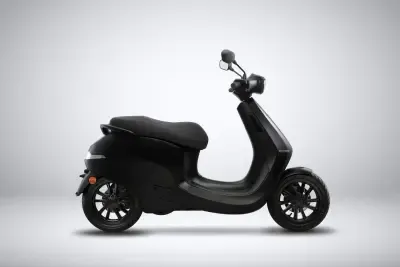Is Ola Electric Losing Its Grip on the Electric Two-Wheeler Market?

Synopsis
Key Takeaways
- Ola Electric sold only 17,848 units in July, a 57.29% drop.
- Market share fell to 17.35% from 38.83%.
- Company's market capitalisation decreased by over 45%.
- Reported a net loss of Rs 428 crore in Q1 FY26.
- Plans to sell 3.25-3.75 lakh vehicles in FY26.
Mumbai, Aug 1 (NationPress) Ola Electric, previously a frontrunner in India's electric two-wheeler sector, is witnessing a significant decline in its market presence. Sales plummeted to 17,848 units in July, marking a dramatic 57.29% decrease from 41,802 units sold during the same month last year, as reported by the government's VAHAN data.
The company, led by Bhavish Aggarwal, saw its market share tumble to 17.35% in July, down from 38.83% in the same month of the previous year.
This downturn has severely impacted Ola Electric's valuation, with its market capitalisation declining by over 45%, dropping from Rs 33,521 crore ($3.95 billion) to Rs 18,190.2 crore ($2.14 billion).
Currently, shares are trading at around Rs 41.2, significantly lower than the initial listing price of Rs 76. Shortly after going public, the stock reached an all-time peak of Rs 157.4.
Over the past six months, the shares have decreased by more than 43.3%, equivalent to Rs 31.69. Year-to-date (YTD), the stock has seen a decline exceeding 52% or Rs 44.84.
The company’s sales volume has also sharply decreased month-over-month, attributed to escalating competition and rising customer grievances, according to several reports.
This sales drop follows a challenging financial performance; in Q1 FY26, Ola Electric reported a net loss of Rs 428 crore, which is nearly 30% higher than losses in the same quarter from the previous year.
Operational revenue fell by almost 50% to Rs 828 crore. E-scooter deliveries for the quarter dropped from 1,25,198 units a year prior to 68,192 units this year.
In a recent communication to shareholders, the company emphasized its commitment to “consolidating and institutionalising operations, enhancing margins, and gearing up for the next growth phase” with new product launches.
Ola Electric anticipates selling between 3.25-3.75 lakh vehicles in FY26, generating revenue between Rs 4,200-4,700 crore.









